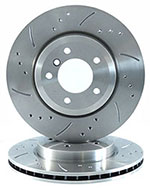Fitting, bedding in and tips to avoid warped discs

When fitting discs always make sure the mounting surfaces of the discs and the hubs are spotlessly clean. Failure to do this can lead to run-out which can lead to a feeling of warped or juddering discs.
Run-out should be a maximum of 0.005” or 0.15mm when measured at the outer edge.
The way discs are manufactured means new discs are very unlikely to be warped, but if you do find run-out when fitting then simply reposition the discs on the hubs, rotate to the next hole location.
It is crucially important that run-out is minimised at the fitting stage, as if there is run-out now it can lead to variation in thickness at a later date that will cause juddering.
You should make sure all calipers and sliding pistons etc are free to move. Any binding can lead to overheated discs and pads, and even bearings.
Bedding in will take around 200 miles. This will allow the pads to establish a good footprint on the discs, with even coverage. For the 1st 200 or so miles avoid emergency or heavy braking.
Warped discs
It is nearly impossible to warp brake discs from normal/fast road use. Vibration through the steering wheel is mostly caused by brake deposits sticking onto the discs. This can occur after some braking and particularly if stopped when the discs and pads are hot i.e. at a junction etc. If at all possible avoid sitting for prolonged periods with the brake pedal applied, or even the handbrake. If you think you have pad deposits on the discs then you can remove them by doing several hard braking procedures in a row and again avoid sitting at the end with the brakes applied. Drive for 1 or 2 miles to allow the discs and pads to cool in a constant manner.
Different pads have different temp ratings. When this operating range is exceeded you can get vibration and juddering. This is simply the pads getting pushed back of the discs when the pedal is applied. Allow the brakes to cool down and all should be ok.










